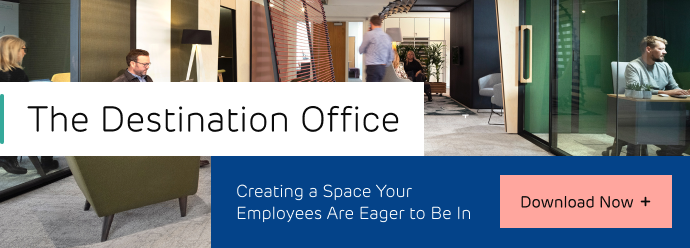A learning revolution has taken place in the workplace. Ongoing training and personal improvement have become a central focus for workers and employers.
For this blog post, we talked to Nuno Correia, Senior Workplace Designer at Insightful Environments, about the purpose and potential of creating spaces that support active learning in the workplace.
What is active learning?
In the knowledge economy, where companies aspire to retain their competitive edge, active learning is the new key to innovation.
Active learning is a paradigm for life-long, proactive education within organisations.
Active learning is a never-ending journey. Rather than thinking of a learning journey. as episodic, like attending a conference or training session, it’s about nurturing a culture that encourages experimentation and has a tolerance for ambiguity and failure.
But the hybrid world frustrates active learning
Ironically, the hybrid digital working that dominates today's working life often results in less day-to-day interaction and knowledge sharing between individuals and teams.
Research published in the Panopto Workplace Knowledge and Productivity Report states that, on average, workers waste 5 hours a week waiting for information - and that 60% of us are frustrated by how hard it is to access knowledge from silos within our organisations.
Source: Panopto
In this new digital world, the buildings where we come together must become learning communities.

Source: Kitt's case study - Spendex
That’s why businesses are re-imagining the workplace, transforming it from a space for day-to-day admin into a dynamic hub designed for continual collaboration, education and professional growth.
Learning might be valued throughout the business, but when we are in our digital foxholes, it’s hard to carve out time and opportunity to be and think together.
What helps you learn from others in the workplace?
The offices we come into can’t be organised as serried ranks of desks and cubicles. The design of our working environments need to spark knowledge sharing and creative collisions.
They must be designed to instil and maintain a ‘learning mindset’ throughout our organisations, which can keep us at the cutting edge of thinking in our sectors.
You can’t synthesise a learning culture or manufacture a love of learning across your business. However, it can be supported from the top down by encouraging more real-world interactions that lead to effective collaborative training.
6 Ways to Improve the Learning Experience in the Workplace
1. Magnetise the workplace and encourage creative collisions
Steelcase’s LINC workspace in Munich is an experimental building designed to test and showcase cutting-edge hybrid working and training methods. In this workspace:
“The designers drew inspiration from urban planning to create an array of interconnected neighbourhoods that enable people to easily flow from one work mode to the next, interacting and learning from each other throughout the day.”
.jpg?width=693&height=390&name=23-0206714%20(1).jpg)
These neighbourhoods are exciting to be in and around.
They are designed to help individuals establish new relationships across teams and departments, triggering new connections like the firing of neurons in the brain:
Innovation doesn’t happen when people are working behind closed doors. It happens when you accidentally walk by something that makes you suddenly realise there’s an untapped potential for synergies.
JESSIE STOREY - Steelcase design director, EMEA
2. Make learning visible
A culture of learning needs to spill out from meeting rooms and presentation areas. It needs to flood into the in-between spaces of the workplace to ignite and inspire the thoughts and actions of others.
Colleagues emerging from formal collaboration spaces should be able to break out into convenient nooks and niches in hallways and atriums to reflect on what has been shared and plan their next steps.

Companies can support this activity by providing break-out and touchdown areas close to meeting rooms.
Ensure there are walls you can write on and big screens you can quickly access to share information and capture thoughts emerging from brainstorms.
Where learning is visible, shared on walls and between colleagues in canteens, it can catch fire and spread,
3. Ensure an engaged and dynamic learning community
With 46% of UK workers working in a hybrid way at least some of the time, modern businesses need to extract the most value from our time together.
But with available space shrinking to reflect a less physically present workforce, it’s hard to host a high-intensity coming together - while ensuring we can deliver moments of quiet and introspection when needed.
In the LINC building, designers worked hard to carve out spaces for privacy and ‘focused work’ even amidst the collaborative chaos:
To make sure people could focus in this vibrant environment, we’ve given a lot of thought to psychological, acoustic and visual privacy. Individual desks are more sheltered than they were in the past. Users have control over dividing screens to signal how much privacy they need. We’ve also made collaboration spaces more sheltered to mitigate distractions.
4. Create a central hub where ‘everyone collides’
During Covid, the three large meeting rooms in the central space of our office saw less and less use. And employees did not feel a sense of permission to be there. To break down those barriers, we dismantled the three meeting rooms, opening up the entire floor.
Where you host hybrid workers, there may be a growing need to find a central place where everyone can be together,

These can be attached to communal eating areas to ensure everyone gravitates towards them; they can serve more than one function, hosting everything from town halls, stand-ups and learning hackathons to post-work drinks and celebrations. The LINC hub is a formal and informal space for learning and sharing.
We created a hub where everyone can connect and contribute to a unique experience. Today, a large communal table and a vertical display create a space to host events, support rituals and create the social moments people are craving.
Nuno Correia points to the success of the central meeting forum in the ARC building at the University of Glasgow. While working with the Uuniversity they discovered:
Creating a place that is a focal point for discussions, coupled with an academic event space on the ground floor, really creates that opportunity for happenstance and serendipitous interactions that are such a key part of research. We need to work across academic boundaries to tackle the world’s biggest challenges.
5. Support different modes of hybrid learning with smarter tech
One of the big advantages of the hybrid working model is the ability to employ people in different territories and access expert training resources from across the world.
However, bridging the gap between digital and in-person meeting participants has been one of the toughest challenges for companies that want to be hybrid and maintain a consistent training and knowledge transfer experience among their teams.

The LINC team found a furniture solution that could eliminate ‘proximity bias’ and make the remote training experience as inclusive as possible.
We’ve installed several Ocular tables of different dimensions in the space. Their unique curved shape eliminates the bias towards in-room participants and improves sightlines on both sides of the screen.
It’s all about making sure no one feels left out, whether they're dialling in from afar or sitting right there. And because everyone can see each other clearly, picking up on those all-important non-verbal cues is easier. Steelcase is thinking ahead about keeping everyone in the loop, no matter where technology heads in the future.
Coupled with the Microsoft Front Row technology, they allow people in the room to see the remote participants’ faces better across the bottom of the monitor, as well as the chat and the content being shared.
6. Give your teams agile furniture to accelerate collaborative learning
Throughout the working day, there are always opportunities to huddle together to share insights or break away to study quietly and absorb new information. Our furnishing decisions can support these efforts in myriad ways.
In the new world of active learning, the key is to help this happen effortlessly and with minimal disruption.
Highly mobile and versatile furniture can support fast and fluid transitions between different work and learning modes in the same space.

Moveable screens can double as whiteboards or pinboards for sharing information and artefacts.
These screens can also help create boundaries and shield open-plan spaces to enable more focused work.
The key to a future of innovation and reinvention is to design spaces that instigate learning as a mindset, not an action. Our buildings must facilitate behavioural shifts that make learning happen everywhere, connecting people inclusively and promoting their well-being.









